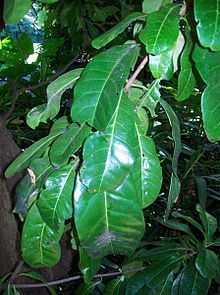Pouteria obovata
| Pouteria obovata | |
|---|---|
 | |
| Royal Botanic Gardens, Sydney | |
| Scientific classification | |
| Kingdom: | Plantae |
| (unranked): | Angiosperms |
| (unranked): | Eudicots |
| (unranked): | Asterids |
| Order: | Ericales |
| Family: | Sapotaceae |
| Genus: | Pouteria |
| Species: | P. obovata |
| Binomial name | |
| Pouteria obovata (R.Br.) Pierre | |
| Synonyms | |
| |
Pouteria obovata is a tree in the Sapotaceae family. Confusingly, this is not the same plant that was formerly known by the same scientific name, the Andean Pouteria lucuma. The common name in Australia is the Northern Yellow Boxwood. It occurs in many parts of south-east Asia, Micronesia, and on islands of the Indian Ocean,[1] and has local common names there.
The tree was first described as Sersalisia obovata by Robert Brown in his 1810 work Prodromus Florae Novae Hollandiae,[2] before being moved to its current binomial name by Baehni in 1942.[3] The specific epithet obovata refers to the reverse ovate shape of the leaf. There is discussion whether this plant should remain named as Planchonella obovata, with the Queensland herbarium supporting this.[4] A genetic analysis of material found that material from Papua New Guinea was isolated and was a sister to a group comprising material from Australia and Indonesia. Indumentum was present on the leaf surface of the Australian and Indonesian samples, and absent in material from Papua New Guinea.[5]
Pouteria obovata grows as a bushy-crowned tree reaching a maximum height of 10 to 20 metres (35–70 ft). The leaves hairy when young, with upper surfaces becoming smooth and shiny. They are roughly oval- to spear-shaped and measure 6–24 cm (2.4-9.6 in) long, and 1.5–15 cm (0.6–6 in) wide. Appearing from August to October, the tiny greenish-white flowers grow in clusters. Flowering is followed by round red or blue berries 1-1.5 cm (0.4-0.6 in) in diameter. Each berry contains one to five seeds which are yellow when ripe.[6]
It can be grown in conditions with good drainage with sunny aspect, and can be propagated by seed. The wood is used for turning and cabinet-making.[6]
References
- ↑ "Pouteria obovata". USA Department of Agriculture.
- ↑ "Sersalisia obovata R.Br.". Australian Plant Name Index (APNI), IBIS database. Centre for Plant Biodiversity Research, Australian Government.
- ↑ "Pouteria obovata (R.Br.) Baehni". Australian Plant Name Index (APNI), IBIS database. Centre for Plant Biodiversity Research, Australian Government.
- ↑ "New names and taxa for Queensland plants, algae, lichens, bryophytes and fungi July 2007 to June 2008". Queensland Government - Environment and Resource Management. Department of Environment and Resource Management, State Government of Queensland. Retrieved 12 December 2010.
- ↑ Teguh Triono, Anthony H. D. Brown, Judy G. West, Michael D. Crisp (2007). "A phylogeny of Pouteria (Sapotaceae) from Malesia and Australasia". Australian Systematic Botany 20 (2): 107–18. doi:10.1071/SB06011.
- ↑ 6.0 6.1 Elliot, Rodger W.; Jones, David L.; Blake, Trevor (1997). Encyclopaedia of Australian Plants Suitable for Cultivation: Vol. 7. Port Melbourne: Lothian Press. p. 357. ISBN 0-85091-634-8.


